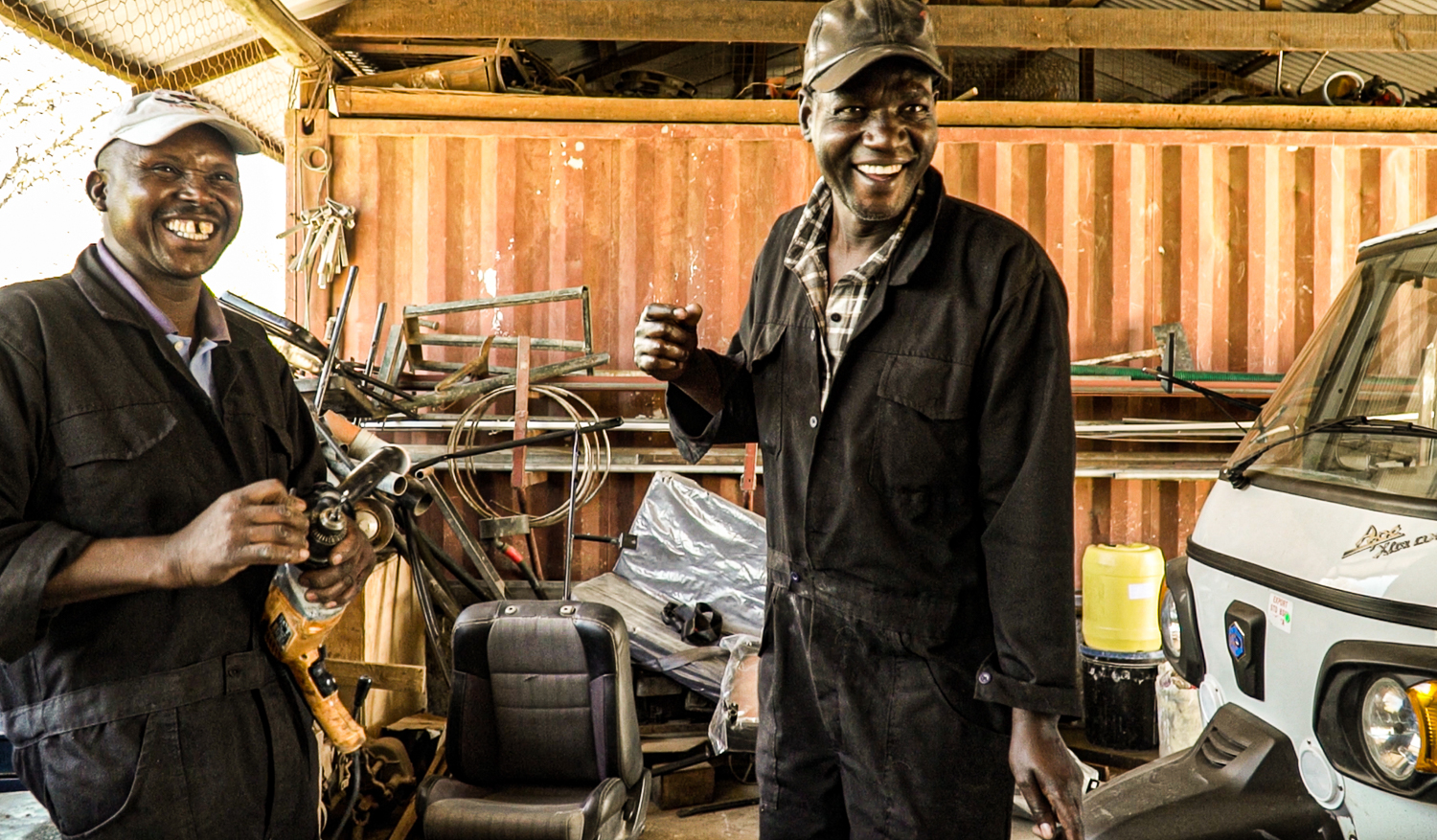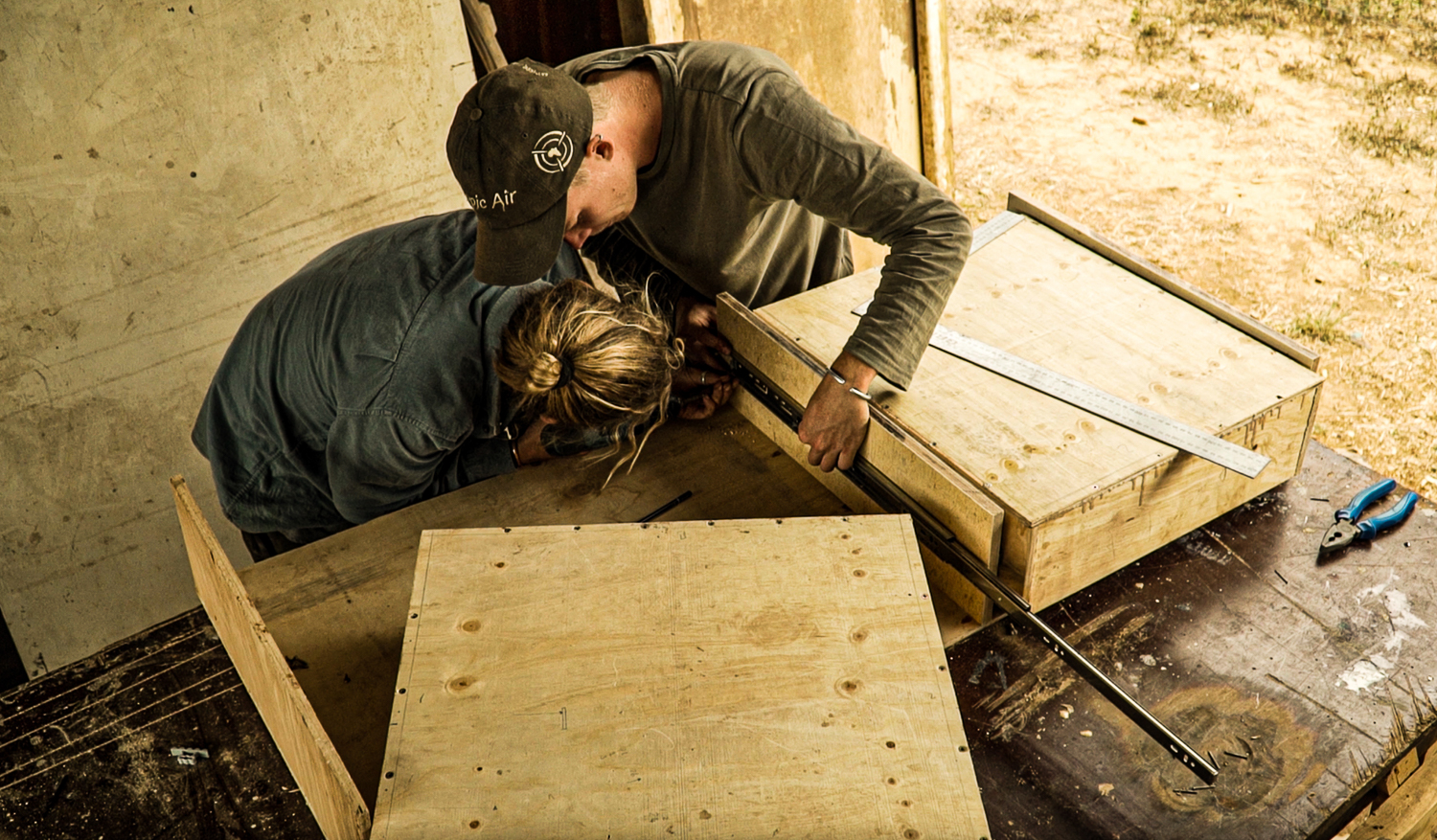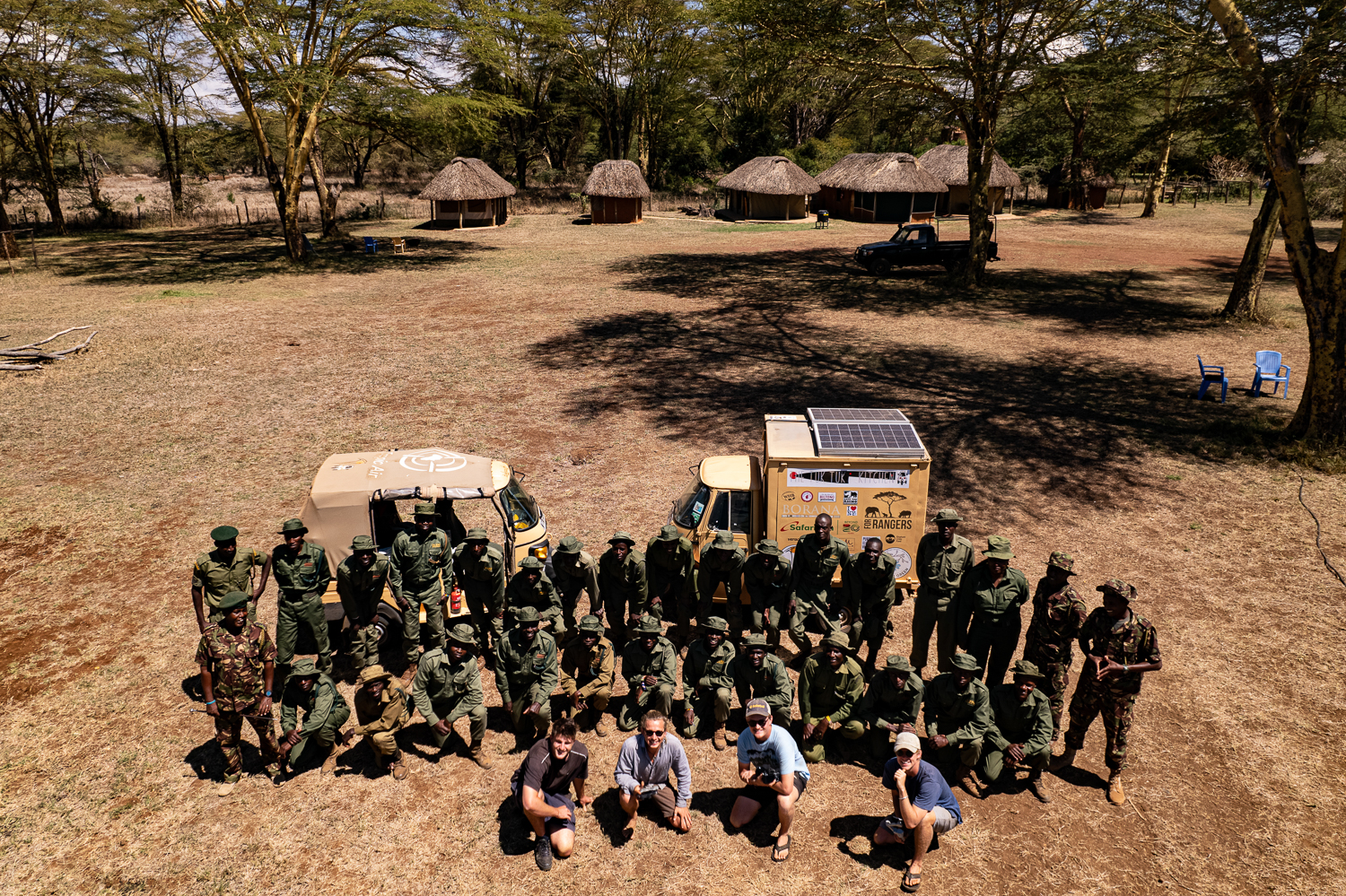What began as an adventure travel documentary project morphed into something more powerful for Robbie, Josh, Jasper, and Ivo of Tuk South. These young British gents are driving 6,000 kilometers from Kenya to Cape Town, using their platform and video production skills to raise funds for African wildlife rangers.
Driving a couple of 8-horsepower tuk-tuks, the group’s story ignites a flame of respect in many of us. Initially choosing this form of transport to raise awareness for the cause, the team quickly discovered the three-wheelers offered something more—an opportunity to connect with local communities. “There’s that little bit of banter, nudging, and laughing; it’s just a perfect potion of smiles,” says Jasper. “Everyone tootles up and wants to have a chat because they are genuinely interested.”
I recently spoke with Josh, Jasper, and Ivo about how their project came to fruition, how they’ve modified their tuk-tuks for overland travel, and what they’ve learned along the way.
How did your backgrounds in conservation help bring this project to fruition?
Jasper: Josh and I worked in Western Indonesia on an archipelago between Borneo, Sumatra, and Java for a year and a half. We were guest relation managers at little eco- or sustainability-centric lodges owned by Australian and Singaporean investment bankers. We [ran] sustainability walks, did watersports for the guests, nature walks, etcetera.
Ivo: When these two were working on the private island, I was still at university studying biology and had all the hopes and dreams of going off to study bottlenose dolphins in Western Australia. But big bad Covid put a stop to that.
Josh: Jasper and I were long-time friends for about 12 years. We had catch-ups once a year, and this was one of those phone calls around Christmas time. He was doing something cool with Ivo and Robbie in Kiwayu, fishing on the [Kenyan] island. As soon as that phone call took place, it was clear that lives post-Covid were sort of left in ruins, or were different, in many ways.
Your initial focus was filming TikTok adventure videos. How did this develop into a documentary-style project and partnership with ForRangers?
Josh: I just hit 100,000 followers on TikTok and had a video about black soldier fly maggots hit 4 million views, so I was pretty excited. When we started hearing the ranger’s stories about how [Covid] impacted them, we got the idea of following a bigger story. During the filming process of interviewing rangers about the impact of Covid, we were inspired to kick it up a little bit and not just try to help passively. A documentary will get exposure, which can lead to funds coming in, but we wanted to take an active role by raising money for these guys.

How has the Covid-19 pandemic affected anti-poaching efforts in Africa?
Ivo: The money that would have come from tourism is no longer there, so the rangers were receiving pressure from the communities toward poaching and logging. The rangers were in a tricky situation, obviously wanting to continue but not having any funds to do so because they’re usually paid through tourism.
When we filmed initially, it was in remote northern areas of Kenya that don’t have Western NGOs or the Kenyan government pumping money into them. Many of these areas become quite dangerous when you’re getting in the way of people fighting to survive, so there was quite a high incidence of ranger deaths in those areas. After hearing their stories, we decided to carry on filming down [south] and try to raise money for them.
You learned a lot about conservation from members of the Milgis Trust and Samburu people in Northern Kenya. How have communities in this region maintained their ability to live in harmony with the environment?
Josh: A good way of conserving land, if you don’t want it sent to farmland (which isn’t usable by wildlife), is by putting beehives in your trees. This means that [the land] can still be used by wild animals. Beehives essentially conserve land because community members can make money from it and not have to deforest. That was one example of what they were doing.
The Samburu have incredible stories about flowers and honey. The honey would do weird things depending on which flower the bees were going for. [We were told that] at a certain time of year, the bee will drink from a [particular] flower and make psychedelic honey. Or this [other] honey, if you’re drinking it and crick your neck, it could make you lose your mind for days, months, even forever! It was like being in Avatar, the way they were connected to the environment.
Jasper: This sect of the Samburu occupies the lowlands and the mountains, so [they have] a diverse array of plant knowledge. They treat ailments by making poultices and splicing them with honey. They are very in touch, whereas the other tribes in Kenya have lost that. Back in the day, they would have all shared [similarities], but industrialization and globalism have pushed them back into the modern world. The Samburu are refusing that in quite a noble fashion, which is cool.
Why did you choose tuk-tuks as your form of transportation?
Josh: It came about through a slip of the tongue by one of us who referred to TikTok (where we were posting our videos) as tuk-tuk. It literally spun out of that.
We’ve loved tuk-tuks for a long time. When we were in Sri Lanka, Jasper and I rented one for a day. You could drive it up and down the roads; people generally put their surfboards on him and take them to the beach. We drove straight into the middle of a game park, where you’re not meant to go in tuk-tuks. There were buffalos, leopards, and elephants, and you had these giant safari cars going everywhere. And it was just me, Jasper, and this other guy in a tuk-tuk, driving around the safari park and having really good fun. And if it gets stuck, you can push it out because it weighs about 200 kilograms.
Jasper: We also thought that, because they are quite endearing-looking things and are never [used as] long-distance vehicles, the ridiculous nature of modifying this urban mobile with all the upgrades could draw attention to the cause. They’re zen machines (despite being rattly) because everything is slow. You’re not thinking of overtaking; your eyes are not beaming on the road just in case a dog comes out because you’re going so slowly that you’ll always have time to stop. You have a lot of time to look out the windows and absorb what you’re going through.

Where did you source the tuk-tuks?
Josh: We got them from Car and General, a boda-boda and tuk-tuk distributor in Kenya. It wasn’t a smooth and simple process. They had stopped printing license plates in Kenya [at that time], so even though we had them, we didn’t get a license plate until three months afterward. We were delayed waiting for a logbook, the tuk-tuk’s passport, and the carnet.
Jasper: If we’d left when we had intended, we would have beaten the rainy season here in East Africa, which we are now in the heart of. We get rained on every day. The whole concept of the mission is to test the tuk-tuks in as many terrains as possible, so we try to avoid tarmac and go into the more remote areas. Sadly, all those roads are [made of] mud, which has now coincided with the rains. The amount of time we spend stuck in the mud is just absurd. The wheels are so small, and the tires wouldn’t look out of place on a tricycle. Luckily you can lift the tuk-tuks, but it’s exhausting!
Where did you carry out the modifications?
Jasper: Ivo and I were born in Northern Kenya, basically on the foothills of Mount Kenya. Our parents have a farm with rosemary, lavender, and lemon verbena; it’s distilled and put in soaps, body wash, and shampoo. Anyway, there’s a little workshop to tend to the farm machinery. Phillip, our main welder from that workshop, is an absolute legend and a wizard at welding. I did the design on AutoCAD, and he was a huge help to this mission.




What’s your average speed?
Jasper: It depends on what we’re doing. [On a] dirt road, 22 kilometers per hour. On tarmac, 42 kilometers an hour. The most ridiculous thing about these brand-new vehicles is that their speedometers don’t really work, so we have to track it on GPS. It feels like you’re flying at warp speed at 60 kph. The problem is they can never quite get to speed. When you drive on corrugations, you’ll get to a speed where you skim over them, but you never achieve that in a tuk-tuk. As soon as you find these long dirt roads with corrugations, your brain feels like it’s hemorrhaging out of both ears.
Ivo: Especially in the van—Princess Buttercup is slower, and the doors rattle so much. I mean, everything kind of rattles. It’s like living inside a drum kit, but we have noise-canceling headphones and listen to music. It’s quite an experience.




You mentioned Princess Buttercup, which is the name of one of your two tuk-tuks. What are the differences between them, and what modifications did you make to each?
Ivo: The other one we call our Sports tuk-tuk, which is kind of a joke. It’s just a three-person standard 430cc Piaggio, so it’s got eight horsepower. It’s a bit of a weapon. We got it brand-new and fiddled with the roll cage. You could bend it in your hands, so we decided to gut it completely. We ripped off the roll cage and the tarp; the seats were rubbish. The farmer [living] next to us had this magician named Kingori who could bend steel pipes. He built us a roll cage in two hours with manual tools. We went to a scrap heap and put seats and a seatbelt in from a wrecked car. It’s got a sump plate to stop our engine getting gutted off, [which is] made of an old fuel drum. It has full jerry can mounts, carries 60 liters of water, and 20 liters of fuel on the front. That one is swanky when you’re traveling around. The other one, the star of the show, we’ve called Princess Buttercup, and I absolutely love her.
Josh: Have you ever seen Princess Bride? Princess Buttercup is like, “Farmboy, do this. Farmboy, do that!” He always says, “As you wish.” That’s how we feel about [Princess Buttercup]. She’s so demanding! We have to push her up hills.
Jasper: So many hills!
Ivo: She’s not designed to be doing the things that we make her do, and we have filled her with enough gear to make a car break, but she plods along. We took a lot of inspiration from American and Australian overlanding rigs and van builds and built a whole frame into the back. It’s got a side door and a kitchen table that pulls out with drawers, a sink for doing your washing, and a 200-watt solar system. Gas is piped into the thing. We’ve got a 6-inch wastewater pipe. It’s a weird s-bend shape, which we sealed on two ends with a bicycle nozzle coming out of one end. You fill it up with water and can pump it with a bicycle pump, and it gives you 20 liters of pressurized water to shower in and wash plates and bowls.
It’s great when you pitch up to places because they see this box tuk-tuk—they’re rare to see—and when you open it up in villages, they love the fact that you have all this tea gear rigged in. While chatting with rangers, you can have the kettle boiling in the background.

What are some of your most challenging moments so far? The most rewarding?
Ivo: We had one where we were foolishly camped on an eluvial plane, and it rained so much it washed away half of our camp. We lost loads of gear and went through that whole depression of ferreting around in this river, trying to find our knives—our whole kitchen washed downriver in this flash flood. We were like, this is so bleak, let’s get out of this place. We started driving, and it took us an hour and a half to move no more than 100 meters. Fast forward six hours, and we could still see the tree we’d been camped under. By now, we were running out of water and were caked with mud. Then you have that one day when you’re face-to-face with a chimp in the Mahale Mountains thinking, life is actually pretty cool. You need the balance.
Jasper: Even though we’ve decided to travel in these tuk-tuks kind of as a joke, I feel like we get more respect as we’re traveling. Not even just respect—people are really interested in what we’re doing. From the smallest children to village elders, everyone comes up because you’re not just in another tinted-windowed Land Cruiser.
When you see a kid looking at you with his mouth open, and you give him a wave, and he beams this smile at you, you know that you’ve blown his mind. He’s like, “What has just happened here?” It’s a great feeling, and you get it 150 times a day.




What’s next for Tuk South?
Josh: When we get to Cape Town, probably around June, we want to ship [the tuk-tuks] to Patagonia and drive them to Alaska. We want to introduce the Americas to the three-wheeled life.
To learn more about Tuk South and ForRangers, visit tuksouth.com and forrangers.com.

Our No Compromise Clause: We carefully screen all contributors to ensure they are independent and impartial. We never have and never will accept advertorial, and we do not allow advertising to influence our product or destination reviews.


